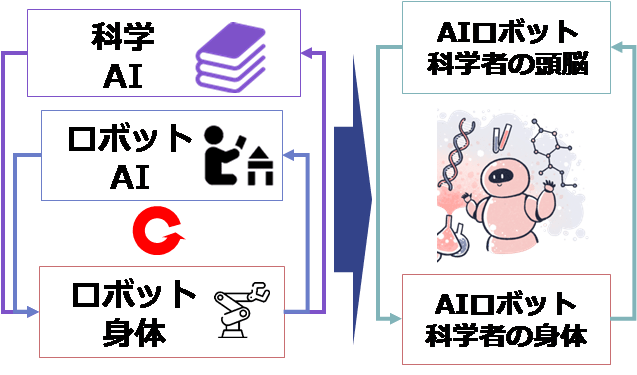Progress Report
Co-evolution of Human and AI-Robots to Expand Science Frontiers[2] Observant & Accurate AI-robot Scientists
Progress until FY2024
1. Outline of the project

Excellent scientists notice even the slightest changes. They can also anticipate where such changes will occur and intervene with pinpoint accuracy. This topic develops AI robot scientists that make this kind of accurate, targeted exploration possible.
- The AI detects subtle cues and hidden patterns to identify the exact targets.
- The AI and robot work together to keep each target continuously in focus, even as it changes.
- They uncover clues that humans overlook and help reveal previously unknown phenomena.
2. Outcome so far
Every cell exhibits its own individuality, and understanding these fine-scale differences is essential. Human vision, however, often fails to notice faint signs or hidden patterns; even when they are recognized, manipulating the exact cell is extremely difficult. Until now, isolating and analyzing specific cells of interest—based on their accurate 3D position or behavior inside an organism—has been very difficult.
To solve this problem, we are building a system in which: The AI analyzes microscope images, detects subtle changes in motion, and predicts which cells should be targeted; The robot then performs pinpoint sampling of those selected cells.

So far, we have developed AI methods that detect subtle changes in the microscopic images, and the robots that can collect the targeted cells.
We applied this technology to root cells, each of which has its own “address” and corresponding function. By analyzing the cells by correlating to their address in the root, we aim to study how plants grow and regenerate (Sato PI). A better understanding of the plant function in fine-scale would lead to strategies for controlling plant development and improving food security.
In this research: The AI assigns addresses to individual cells in a root which is as thin as a strand of hair (Mori PI); As enzymes gradually separate the cells, the AI tracks their position in 3D in real time; The robot pinpoints and collects individual cells one by one (Takeuchi PI and Arai PI).
Using this method, we successfully collected specific cells for the first time in a 3D-tracked manner—the cells that human scientists had wanted to study but could not reach with the human eye and hand.

We are extending the same approach to animal cells. In work on vascular disease (Takebe PI), we have developed the AI method that tracks all cells flowing through a microvessel that is as thin as a hair (Mori PI).
Even cells of the same type in the microvessel behave differently; we are creating a robot that can collect those that may trigger disease for detailed analysis (Arai PI). Studying disease mechanisms at single-cell resolution by correlating individual behavior to its function could lead to therapies that prevent pathological changes before they start.

3. Future plans
Elucidating how drugs and nutrients act in plants, animals, and humans requires analysis at cellular resolution. By harnessing the unique strengths of AI-robot scientists—superior observation, precise hand-eye coordination, and accurate targeting—we can perform experiments that were once beyond human observation and manipulation capabilities, recover previously inaccessible clues, and uncover previously uncharacterized phenomena.